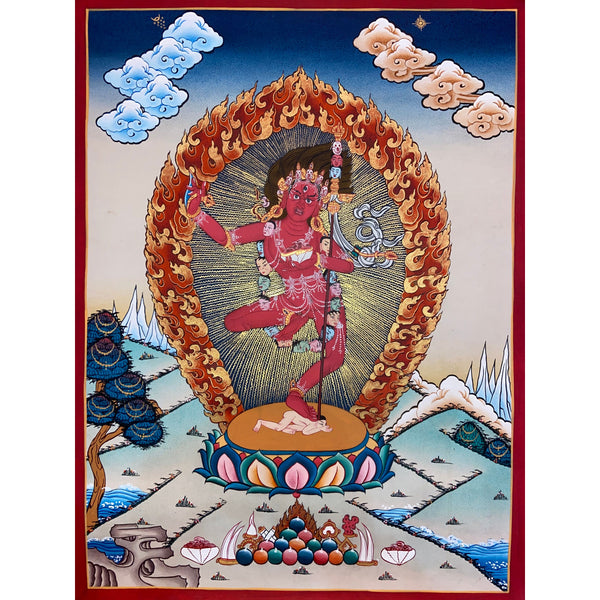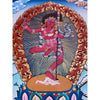Vajravarahi / Dorje Phagmo Thangka Painting
SPRING SALE
Get it between - .

Vajravarahi / Dorje Phagmo Thangka – Female Buddha of Protection and Transformation
This 100% hand-drawn Vajravarahi Thangka is a magnificent spiritual artwork, meticulously crafted in the Kathmandu Valley, Nepal. It serves as a unique and powerful centerpiece, perfect for decorating your home, office, or family altar. This exquisite Thangka not only enhances your space with its striking beauty but also brings spiritual and emotional healing, drawing upon the benevolent energy of Tibetan Buddhist art.
Specifications
- Masterpiece Thangka
- Dimensions: 63 x 46 cm
- Materials: Dust of Gold with Tibetan Colors mixed with Hide Glue
- Canvas: Organic Cotton
- Origin: Nepal
- Hand Painted in Nepal
Vajravarahi, also known as Dorje Phagmo, represents the complete Buddhahood in female form and is deeply connected with the Chakrasamvara Cycle of Anuttarayoga Tantra. Though her practice spans across all Tibetan Buddhist traditions, Vajravarahi holds special significance in the Kagyu tradition, where she has been a powerful figure, often appearing to and bestowing initiations upon Mahasiddhas.
Vajravarahi’s image is a symbol of the potent energies of protection, transformation, and enlightenment. When making offerings to her, practitioners connect with this powerful female Buddha, planting seeds of enlightenment within their minds. Her presence helps to pacify the immediate environment, clear negative energies, and protect from harmful influences.
Gestures and Attributes
Vajravarahi is depicted holding a cemetery knife in her right hand and a skull cup in her left, embodying her role in cutting through ignorance and offering wisdom. The khatvanga staff, held in the crook of her left elbow, symbolizes her authority in the spiritual realm. Her stance, with legs in a celestial dancing posture atop a human corpse, illustrates her mastery over the transmutation of death and suffering into liberation. The sow’s head placed on her own is a symbolic representation of her victory over ignorance, reminding us of the transformative power of wisdom.
Key Benefits
- Protection from Negative Energies: Vajravarahi’s image serves as a powerful shield, clearing harmful influences from your environment and providing spiritual protection.
- Transformative Energy: Her wrathful expression and powerful iconography invite the transformation of negative emotions, thoughts, and karmic obstacles.
- Aid for Meditation: This Thangka enhances meditation practice, creating an atmosphere conducive to wisdom and enlightenment.
- Spiritual Blessings: By inviting her presence, practitioners are blessed with guidance toward deeper wisdom and peace.
A Powerful Presence for Your Space
This Vajravarahi Thangka is not only a stunning work of art but a dynamic representation of feminine wisdom and strength. It invites a profound connection to the energies of transformation and spiritual protection, making it a meaningful addition to your altar or home.
You can find answers to common questions on our FAQ page here.
View all our shop reviews at reviews page here.











